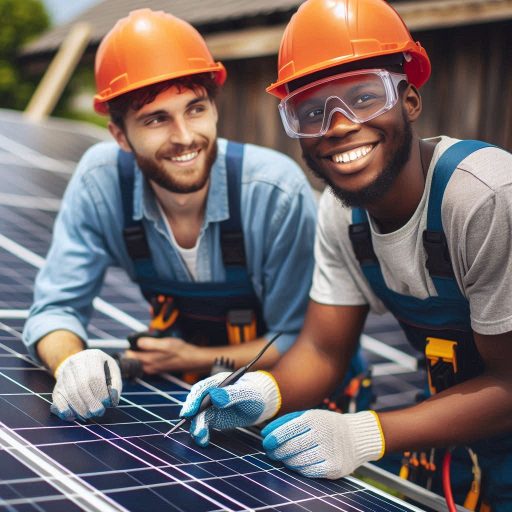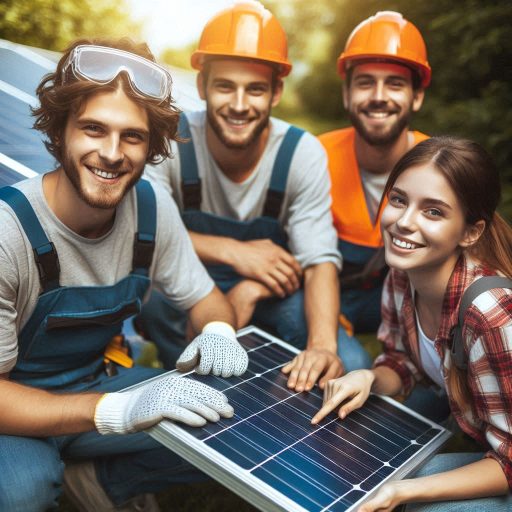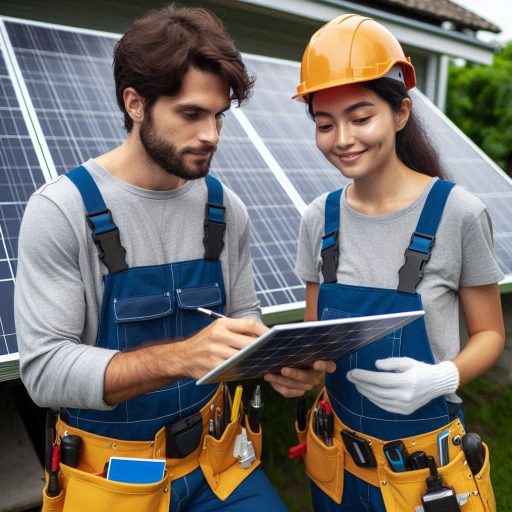Introduction
Solar PV Installers Tools and Equipment systems harness solar energy to generate electricity.
Effective installation of these systems relies heavily on the use of specialized tools and equipment.
Understanding the role of these tools is crucial for both efficiency and safety.
Importance of Tools and Equipment
The success of a solar PV installation depends on using the right tools and equipment.
Each tool serves a specific purpose, ensuring precise and effective installation.
High-quality tools enhance the accuracy of measurements and connections, which directly impacts system performance.
Proper tools help in the secure and reliable mounting of solar panels.
They facilitate the accurate alignment and positioning of panels, which optimizes energy capture.
Additionally, tools designed for electrical work ensure safe and effective wiring of the system.
Increasing Efficiency and Safety
Using the right tools can significantly increase installation efficiency.
For instance, a solar panel installation tool kit typically includes mounting hardware, drills, and alignment tools.
These tools streamline the installation process, reducing the time needed to complete the job.
Measurement tools like laser distance meters help in achieving precise panel placement.
Accurate measurements prevent misalignments that could affect system performance.
Tools that ensure proper torque on bolts and screws also help in securing the panels firmly.
Safety is a major concern in solar PV installations.
Tools such as insulated screwdrivers and circuit testers help prevent electrical hazards.
Proper harnesses and ladders ensure safe working conditions, especially when working at heights.
Essential tools for solar PV installation
List of Tools
Solar photovoltaic (PV) installation requires several essential tools to ensure a successful and efficient setup. Key tools include:
- Drills: Used to create holes for mounting hardware.
- Screwdrivers: Used for tightening and loosening screws.
- Wire strippers: Essential for preparing electrical wires.
- Tape measures: Necessary for accurate measurements and markings.
- Levels: Ensure panels are installed evenly.
- Crimping tools: Used to join electrical connectors.
- Wrenches and socket sets: Tighten nuts and bolts.
- Safety gear: Gloves and safety glasses protect installers.
- Multimeters: Measure voltage, current, and resistance in electrical circuits.
How Each Tool Is Used
- Drills: Create holes in surfaces for securing mounting brackets and panels. Cordless drills are popular for their portability and ease of use.
- Screwdrivers: Tighten and loosen screws essential for attaching panels and hardware. Different types, such as flathead and Phillips, are used based on the screw heads.
- Wire strippers: Remove insulation from electrical wires, preparing them for connections. Proper stripping ensures secure and reliable electrical connections.
- Tape measures: Measure and mark locations accurately to align panels and hardware correctly. Accurate measurements prevent installation errors.
- Levels: Check the horizontal and vertical alignment of panels. Proper alignment maximizes energy efficiency and ensures a professional appearance.
- Crimping tools: Compress metal connectors onto wires, creating secure electrical connections. High-quality crimping ensures durability and reduces the risk of faults.
- Wrenches and socket sets: Tighten various nuts and bolts involved in mounting and securing equipment. Having a range of sizes ensures compatibility with different fasteners.
- Safety gear: Gloves prevent cuts and abrasions, while safety glasses protect against debris and particles during installation.
- Multimeters: Test electrical circuits for voltage, current, and resistance. Accurate testing helps diagnose issues and ensures proper system operation.
Importance of Having High-Quality Tools
High-quality tools are crucial for both durability and accuracy in solar PV installation.
Durable tools withstand the demands of the installation process, reducing the likelihood of tool failure and ensuring longevity.
Accurate tools improve the precision of measurements and connections, leading to a more reliable and efficient solar PV system.
Investing in quality tools enhances overall installation quality, minimizes errors, and ensures that the system performs optimally over its lifespan.
for a successful solar PV installation.
By investing in high-quality tools, installers can work efficiently, accurately, and safely, ensuring a top-notch installation that will generate clean energy for years to come.
Specialized equipment for solar PV installation
Description of Equipment Like Solar Panel Lifters, Torque Wrenches, Etc.
Solar PV installation relies on specialized tools to ensure efficiency and safety.
Solar panel lifters are essential for handling heavy panels, making placement on rooftops easier.
They reduce physical strain and prevent potential injuries.
Torque wrenches are used to apply the correct amount of torque to bolts and fasteners.
This ensures that all components are securely fastened according to the manufacturer‘s specifications.
Wire strippers and crimpers are crucial for preparing and connecting electrical wires.
They ensure reliable electrical connections, minimizing the risk of faults.
Multimeters measure voltage, current, and resistance, helping diagnose electrical issues.
Solar panel cleaning equipment, including soft brushes and squeegees, helps maintain panel efficiency by removing dirt and debris.
Benefits of Using Specialized Equipment for Specific Tasks
Using specialized equipment enhances installation efficiency and quality.
Solar panel lifters streamline the placement process, reducing the risk of panel damage and installer injuries.
Torque wrenches ensure that fasteners are tightened correctly, which contributes to the system‘s stability and longevity.
Proper wire strippers and crimpers lead to more reliable electrical connections, which are crucial for the system’s performance.
Multimeters allow for accurate diagnostics and adjustments, ensuring optimal system operation.
Regular cleaning with the right tools helps maintain peak performance and energy output.
Overall, specialized equipment contributes to safer, faster, and higher-quality installations.
Cost Considerations for Investing in Specialized Equipment
Investing in specialized equipment involves significant upfront costs but offers long-term benefits.
High-quality tools can lead to more efficient installations and fewer errors, ultimately reducing labor costs.
The initial investment in equipment like solar panel lifters and torque wrenches can pay off through improved installation speed and quality.
Although the cost may be high, the increased efficiency and reduced risk of costly mistakes often result in long-term savings.
Additionally, proper tools can enhance customer satisfaction, leading to more referrals and business opportunities.
Balancing the initial costs with the potential benefits is key when deciding on investments in specialized equipment.
In summary, specialized equipment plays a critical role in solar PV installation.
Understanding the description, benefits, and cost considerations of these tools can help ensure a successful and efficient installation process.
Read: Continuing Education for Radiologic Technologists
Safety Gear for Solar PV Installers
Overview of Necessary Safety Gear
Safety gear is crucial for solar PV installers, ensuring protection from various hazards.
Essential equipment includes gloves, helmets, safety glasses, and harnesses.
Gloves are vital for handling electrical components and protecting hands from sharp edges.
They are often insulated to prevent electric shocks.
Helmets safeguard installers from falling objects and head injuries.
They must be durable and meet specific safety standards.
Safety glasses shield eyes from dust, debris, and intense sunlight, preventing injuries caused by particles and glare.
Harnesses are crucial for working at heights, preventing falls and ensuring safety on rooftops and elevated surfaces.
Safety boots offer stability and protect feet with steel toes and slip-resistant soles.
Protective clothing, such as long sleeves and pants made from durable materials, shields against sharp objects and extreme weather conditions.
Hearing protection, like earplugs or earmuffs, is important in noisy environments to reduce exposure to harmful noise levels.
Importance of Prioritizing Safety During Installation
Prioritizing safety during installation is essential.
Solar PV systems involve working at heights and handling electrical components, which presents inherent risks.
Ignoring safety measures can lead to serious injuries or fatalities.
Proper use of safety gear and adherence to safety protocols ensure a safer working environment.
Regular safety training updates are necessary to keep installers informed about best practices and new regulations.
Emphasizing safety not only protects installers but also contributes to the overall success of the installation.
Compliance with Safety Regulations and Standards
Compliance with safety regulations and standards is mandatory for solar PV installers.
They must follow local and national safety guidelines to minimize risks.
Regulatory bodies establish standards for safety gear and installation practices to prevent accidents.
Adhering to these regulations ensures a safer working environment and promotes best practices.
Installers must stay updated on changes to safety regulations to maintain compliance and ensure continued protection on the job.
Read: Future of CAD Technician Jobs in Engineering

Maintenance tools for solar PV systems
Tools needed for routine maintenance of solar panels
Whether you are a professional solar PV installer or a DIY enthusiast, having the right maintenance tools is crucial for the upkeep of solar panel systems.
Some of the essential tools needed for routine maintenance include:
- Soft-bristle brush: Used to gently clean dirt and dust from the surface of solar panels without scratching them.
- Non-abrasive sponge or cloth: Ideal for wiping down panels and removing any stubborn debris.
- Mild dish soap or specialized solar panel cleaner: Helps to effectively remove built-up grime and bird droppings.
- Squeegee: Useful for drying panels after cleaning them to prevent streaking.
- Safety gear: This includes gloves, safety glasses, and a sturdy ladder to ensure your protection while working on rooftops.
How maintenance tools can prolong the lifespan of solar PV systems
Regular maintenance is essential for the optimal performance and longevity of solar PV systems.
The use of proper maintenance tools can help prevent issues such as reduced energy output, efficiency losses, and potential damage to panels.
By keeping panels clean and well-maintained, you can ensure that they continue to generate electricity efficiently for years to come.
Tips on regular maintenance practices for installers
To maximize the lifespan of solar PV systems, installers should follow these best practices for regular maintenance:
- Schedule regular inspections: Check panels for signs of damage, dirt, or shading to identify any issues early.
- Clean panels regularly: Remove dirt, dust, leaves, and debris that can block sunlight from reaching the panels.
- Monitor performance: Keep track of energy production to detect any drops in output that may indicate a problem.
- Trim surrounding vegetation: Ensure that trees or bushes do not shade or damage panels.
- Check for loose connections: Inspect wiring and connections to prevent potential electrical malfunctions.
By following these maintenance tips and using the right tools.
Solar PV installers can prolong the lifespan of solar panel systems and ensure optimal performance for their customers.
Read: Best Online Courses for CAD Technician Training
Upcoming advancements in tools and equipment for solar PV installation
As technology continues to evolve, the tools and equipment used by solar PV installers are also undergoing significant advancements.
These emerging technologies are revolutionizing the solar industry, making installations more efficient and productive.
Overview of emerging technologies in the solar industry
One of the most exciting developments in solar PV installation is the introduction of smart tools and equipment.
These devices are equipped with sensors and data analysis capabilities, allowing installers to monitor and optimize performance in real-time.
Another emerging technology is the use of drones for site surveys and thermal imaging.
Drones can quickly and accurately assess a site’s suitability for solar installation, saving time and reducing human error.
Battery storage solutions are also becoming more prevalent in the solar industry.
These advanced systems allow for energy storage and backup power, increasing the overall efficiency and reliability of solar PV installations.
Transform Your Career Today
Unlock a personalized career strategy that drives real results. Get tailored advice and a roadmap designed just for you.
Start NowHow new tools and equipment can improve efficiency and productivity
The implementation of these new tools and equipment can significantly improve the efficiency and productivity of solar PV installations.
Smart tools enable installers to diagnose and troubleshoot issues faster, reducing downtime and maximizing energy production.
Using drones for site surveys can expedite the planning and design process, resulting in quicker installations and minimized costs.
Additionally, battery storage solutions enhance the system’s performance and reliability, ensuring continuous energy supply.
Overall, these advancements streamline the installation process, making it more seamless and cost-effective.
By embracing these new technologies, installers can maximize their output and deliver high-quality solar solutions to their customers.
Importance of staying updated with the latest innovations in the field
Staying abreast of the latest innovations in tools and equipment is crucial for solar PV installers.
By adopting new technologies, installers can differentiate themselves in the market, offering cutting-edge solutions to their customers.
Moreover, staying updated allows installers to stay competitive and meet the growing demands of the industry.
As the solar market continues to expand, keeping pace with advancements ensures that installers remain relevant and sought after by customers.
Ultimately, investing in new tools and equipment is a strategic move that can drive business growth and success in the ever-evolving solar industry.
By embracing innovation, installers can position themselves as leaders in the field, setting new standards for quality and performance.
Read: CAD Technician vs. Draftsman: Key Differences
Best practices for using tools and equipment in solar PV installation
Overview of Necessary Safety Gear
Safety gear is crucial for solar PV installers, ensuring protection from various hazards.
Essential equipment includes gloves, helmets, safety glasses, and harnesses.
Gloves are vital for handling electrical components and protecting hands from sharp edges.
They are often insulated to prevent electric shocks.
Helmets safeguard installers from falling objects and head injuries.
They must be durable and meet specific safety standards.
Safety glasses shield eyes from dust, debris, and intense sunlight, preventing injuries caused by particles and glare.
Harnesses are crucial for working at heights, preventing falls and ensuring safety on rooftops and elevated surfaces.
Safety boots offer stability and protect feet with steel toes and slip-resistant soles.
Protective clothing, such as long sleeves and pants made from durable materials, shields against sharp objects and extreme weather conditions.
Hearing protection, like earplugs or earmuffs, is important in noisy environments to reduce exposure to harmful noise levels.
Importance of Prioritizing Safety During Installation
Prioritizing safety during installation is essential.
Solar PV systems involve working at heights and handling electrical components, which presents inherent risks.
Ignoring safety measures can lead to serious injuries or fatalities.
Proper use of safety gear and adherence to safety protocols ensure a safer working environment.
Regular safety training updates are necessary to keep installers informed about best practices and new regulations.
Emphasizing safety not only protects installers but also contributes to the overall success of the installation.
Compliance with Safety Regulations and Standards
Compliance with safety regulations and standards is mandatory for solar PV installers.
They must follow local and national safety guidelines to minimize risks.
Regulatory bodies establish standards for safety gear and installation practices to prevent accidents.
Adhering to these regulations ensures a safer working environment and promotes best practices.
Installers must stay updated on changes to safety regulations to maintain compliance and ensure continued protection on the job.
Tips on Proper Tool Maintenance and Storage
Proper tool maintenance and storage are critical for safety and efficiency.
Regularly inspect tools for damage or wear and perform necessary repairs.
Keep tools clean and lubricated to ensure optimal performance.
Store tools in a dry, secure location to prevent rust and loss.
Using tool-specific storage solutions helps keep them organized and easily accessible.
Proper maintenance extends the life of tools and ensures they function correctly.
Importance of Following Manufacturer Guidelines for Equipment Usage
Following manufacturer guidelines for equipment usage is crucial for safety and efficiency.
Each tool or piece of equipment comes with specific instructions on operation and maintenance.
Ignoring these guidelines can lead to improper use, accidents, or equipment failure.
Adhering to manufacturer recommendations ensures tools perform as intended and maintains safety standards.
Always review and follow the provided instructions for optimal performance and safety.
Training Recommendations for Installers to Ensure Proper Tool Handling
Training is essential for ensuring proper tool handling.
Installers should receive comprehensive training on tool use, maintenance, and safety procedures.
Hands-on training helps installers become familiar with the equipment and its proper handling.
Regular refresher courses keep skills up-to-date and reinforce best practices.
Effective training reduces the risk of accidents and improves overall efficiency during installations.
Explore Further: Materials Engineering: Entry-Level Job Guide
Conclusion
Tools and equipment play a crucial role in solar PV installation.
They ensure precision, efficiency, and safety throughout the process.
Using the right tools improves the installation’s overall quality and performance.
Proper tools help prevent errors and reduce the risk of damage to components.
They also contribute to a safer working environment by minimizing potential hazards.
Investing in high-quality tools enhances the efficiency of solar PV installations.
Quality tools last longer and perform better, ultimately saving time and money.
They help installers achieve accurate and reliable results, leading to improved system performance and customer satisfaction.
Using well-maintained equipment reduces the likelihood of unexpected issues during the installation.
Staying updated with advancements in solar PV technology and tools is essential.
New tools and equipment can offer improved functionality, better safety features, and increased efficiency.
Installers should regularly review and upgrade their toolsets to keep pace with industry developments.
This approach ensures they remain competitive and deliver high-quality installations.
[E-Books for Sale]
The Big Book of 500 High-Paying Jobs in America: Unlock Your Earning Potential
$19.99 • 500 High-Paying Jobs • 330 pages
Explore 500 high-paying jobs in America and learn how to boost your career, earn more, and achieve success!
See All 500 High-Paying Jobs of this E-Book
1001 Professions Without a Degree: High-Paying American Jobs You Can Start Now
$19.99 • 1001 Professions Without a Degree • 174 pages
Discover 1001 high-paying jobs without a degree! Unlock career tips, skills, and success strategies for just $19.99!




